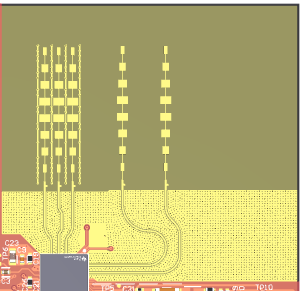SWRU619A July 2024 – December 2024
- 1
- Description
- Applications
- Get Started
- Features
- 6
- 1Evaluation Module Overview
-
2Hardware
- 2.1 xWRL1432BOOST-BSD Antenna
- 2.2 EVM Mux Block Diagram
- 2.3 Switch Settings
- 2.4 LEDs
- 2.5 Connectors
- 2.6 USB Connector
- 2.7 DCA1000 HD Connector
- 2.8 Booster Pack Connector for the LaunchPad Connectivity
- 2.9 SPI-CAN Driver
- 2.10 CAN-FD Connector
- 2.11 LIN PHY Connection
- 2.12 I2C Connections
- 2.13 XDS110 Interface
- 2.14 Flashing the Board
- 2.15 DCA1000EVM Mode
- 2.16 PCB Storage and Handling Recommendations:
- 3Software
- 4Hardware Design Files
- 5Additional Information
- 6References
- Revision History
2.1 xWRL1432BOOST-BSD Antenna
The xWRL1432BOOST-BSD includes three receiver and two transmitter antennas. These antennas are designed as a high gain series-fed patch antenna connected to the the device using Grounded Coplanar Waveguide. To achieve best performance at high frequencies, Rogers RO3003 was selected as the dielectric substrate for the antennas. Figure 2-5 shows the antenna configuration.
 Figure 2-5 TX and Rx Antennas of the EVM
Figure 2-5 TX and Rx Antennas of the EVMNote: Each of the series fed patch antennas on the xWRL1432BOOST-BSD has a gain of approximately 13 dBi. The three RX antennas are located on the left, and the two TX antennas are lcated on the right.